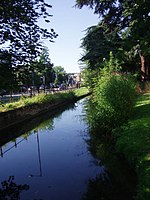Sir William Dunn Institute of Biochemistry
1924 establishments in EnglandBiochemistry research institutesBiological research institutes in the United KingdomInstitutions of the University of Cambridge
The Sir William Dunn Institute of Biochemistry at Cambridge University was a research institute endowed from the estate of Sir William Dunn, which was the origin of the Cambridge Department of Biochemistry. Created for Frederick Gowland Hopkins on the recommendation of Walter Morley Fletcher, it opened in 1924 and spurred the growth of Hopkins's school of biochemistry. Hopkins's school dominated the discipline of biochemistry from the 1920s through the interwar years and was the source of many leaders of the next generation of biochemists, and the Dunn bequest inaugurated a period of rapid expansion for biochemistry.
Excerpt from the Wikipedia article Sir William Dunn Institute of Biochemistry (License: CC BY-SA 3.0, Authors).Sir William Dunn Institute of Biochemistry
Lensfield Road, Cambridge Petersfield
Geographical coordinates (GPS) Address Nearby Places Show on map
Geographical coordinates (GPS)
| Latitude | Longitude |
|---|---|
| N 52.198 ° | E 0.124 ° |
Address
Lensfield Road 43
CB2 1EN Cambridge, Petersfield
England, United Kingdom
Open on Google Maps









